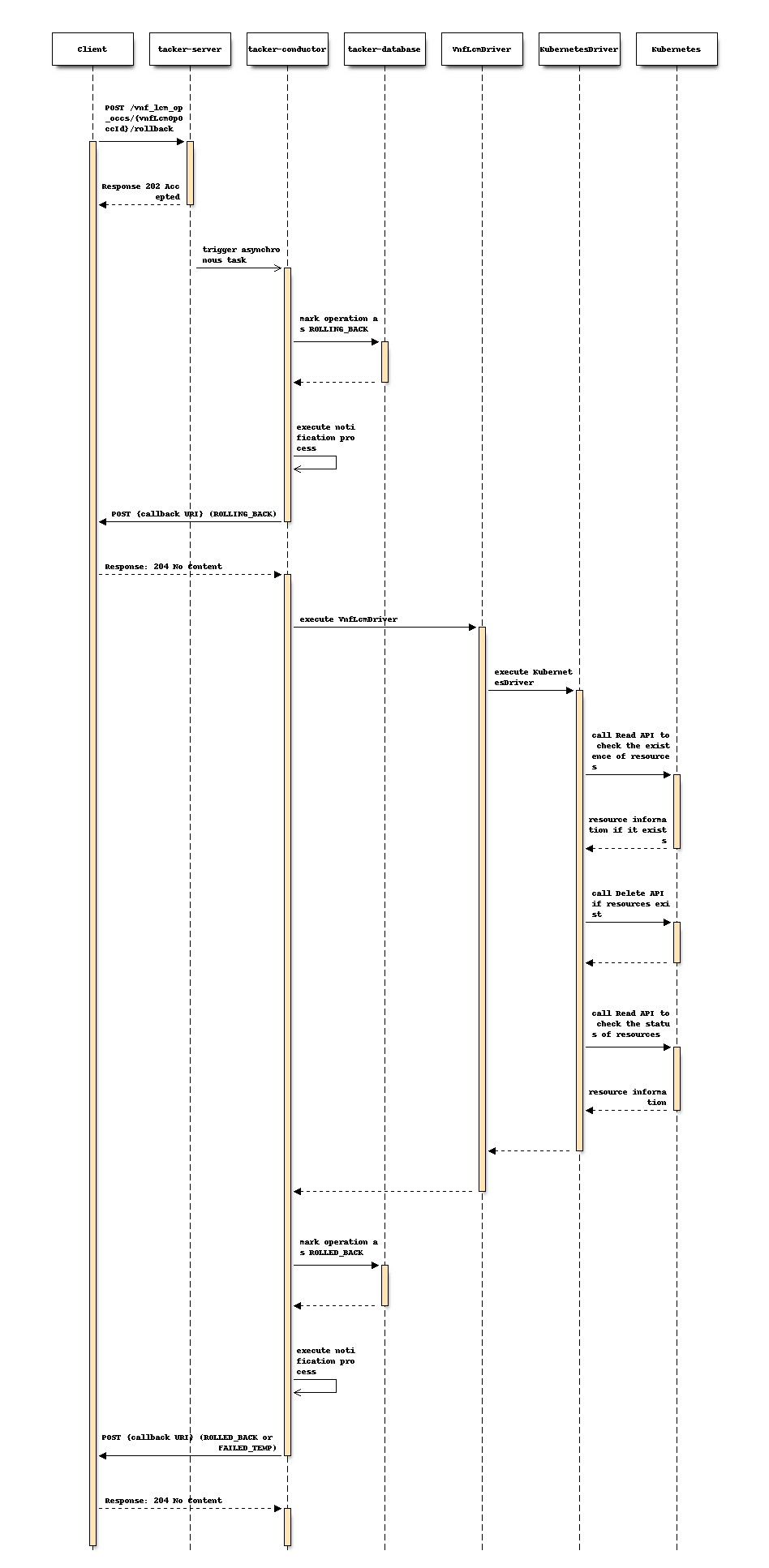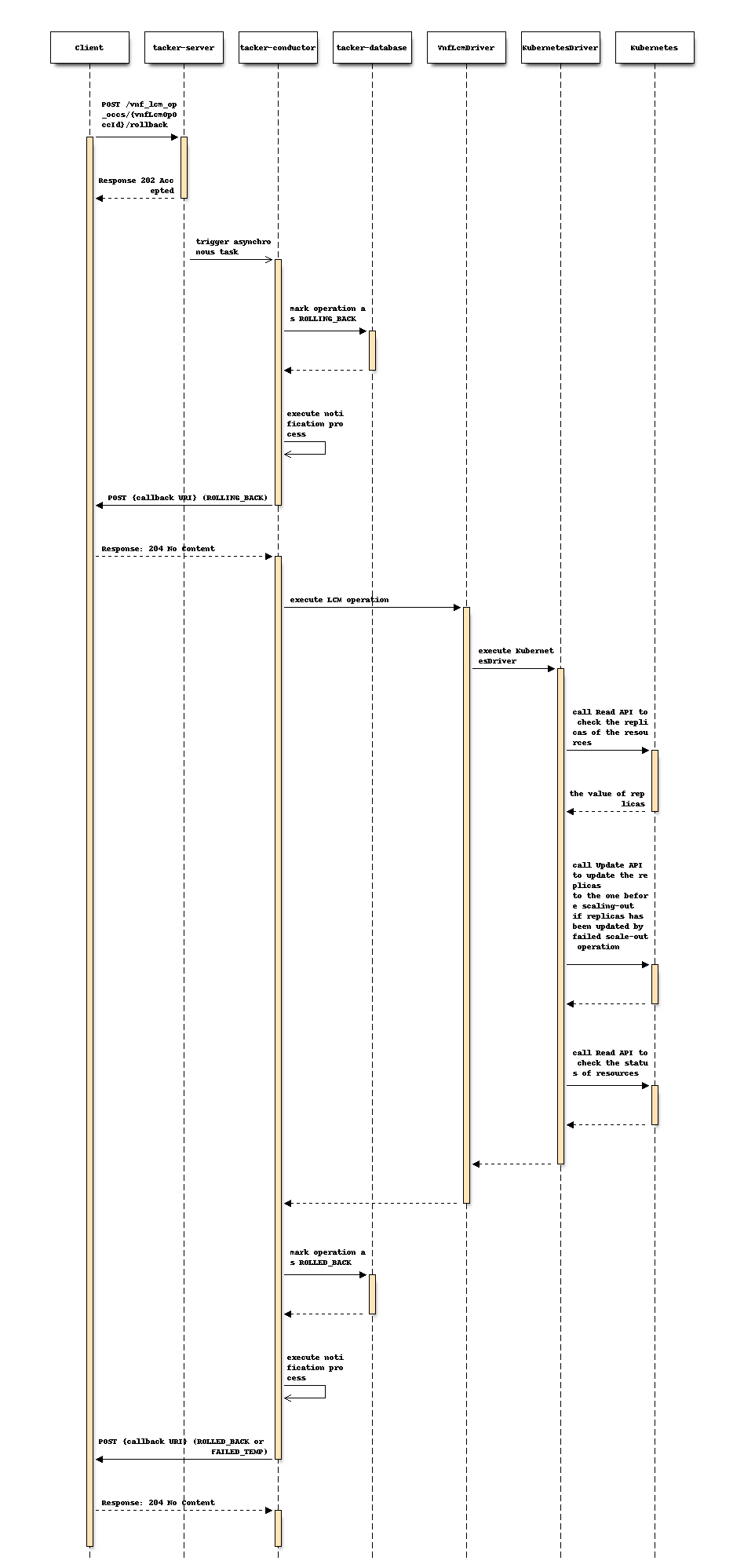Support CNF Rollback in v2 LCM API¶
https://blueprints.launchpad.net/tacker/+spec/support-nfv-solv3-error-handling
This specification enhances version 2 (v2) of Rollback API for supporting CNF.
Problem description¶
Yoga release supported VNF Lifecycle Management (LCM) operations defined in ETSI NFV SOL002 v3.3.1 [1] and SOL003 v3.3.1 [2]. It also supported CNF Lifecycle Management with v2 APIs such as Instantiate API, Terminate API, and ChangeCurrentVnfPackage API.
However, v2 Rollback API has not completely supported CNF LCM yet. Supporting CNF in v2 LCM API makes Tacker more powerful generic VNFM.
Proposed change¶
This specification enhances the following API to support CNF.
Rollback VNF Task (POST /vnf_lcm_op_occs/{vnfLcmOpOccId}/rollback)
v2 Rollback for Change Current VNF Package has already been supported in Yoga release. Also, Modify VNF Information for CNF has already supported in v2 LCM API because there is only common processing with VNF. Therefore, this specification proposes supporting v2 CNF Rollback for following APIs.
Instantiate VNF
Scale-out VNF
Note
Change external VNF connectivity for CNF and its rollback are not supported because the related standard specification has not been defined by ETSI NFV yet.
Rollback for Instantiation¶
There is no change from the current implementation except for InfraDriver (KubernetesDriver) processing.

The procedure consists of the following steps as illustrated in above sequence:
Precondition: VNF lifecycle management operation occurrence is in “FAILED_TEMP” state.
The Client sends a POST request with an empty body to the “Rollback operation” resource.
VNFM sends endpoints such as Client a VNF lifecycle management operation occurrence notification with the “ROLLING_BACK” state to indicate the processing occurrence of the lifecycle management operation.
VNFM sends Kubernetes a Read request to check the existence of resources.
If resources has been created by failed instantiate operation, VNFM sends Kubernetes a Delete request to delete the resources.
VNFM sends Kubernetes a Read request to check whether resources were deleted.
On successful rollback, VNFM sends endpoints such as Client a VNF lifecycle management operation occurrence notification with the “ROLLED_BACK” state to indicate successful completion of the operation.
On unsuccessful rollback, VNFM sends endpoints such as Client a VNF lifecycle management operation occurrence notification with the “FAILED_TEMP” state to indicate an intermediate error (rollback failed) of the operation.
Postcondition: The VNF lifecycle management operation occurrence is in one of the following states: “FAILED_TEMP”, “ROLLED_BACK”.
KubernetesDriver calls following API to delete resources and check status of them.
API Group |
Type |
API method |
|---|---|---|
ApiregistrationV1Api |
Read |
read_<kind> |
Delete |
delete_<kind> |
|
AppsV1Api |
Read |
read_namespaced_<kind> |
Delete |
delete_namespaced_<kind> |
|
AutoscalingV1Api |
Read |
read_namespaced_<kind> |
Delete |
delete_namespaced_<kind> |
|
BatchV1Api |
Read |
read_namespaced_<kind> |
Delete |
delete_namespaced_<kind> |
|
CoordinationV1Api |
Read |
read_namespaced_<kind> |
Delete |
delete_namespaced_<kind> |
|
CoreV1Api |
Read |
read_namespaced_<kind> |
Delete |
delete_namespaced_<kind> |
|
Read |
read_<kind> |
|
Delete |
delete_<kind> |
|
NetworkingV1Api |
Read |
read_namespaced_<kind> |
Delete |
delete_namespaced_<kind> |
|
RbacAuthorizationV1Api |
Read |
read_namespaced_<kind> |
Delete |
delete_namespaced_<kind> |
|
Read |
read_<kind> |
|
Delete |
delete_<kind> |
|
SchedulingV1Api |
Read |
read_<kind> |
Delete |
delete_<kind> |
|
StorageV1Api |
Read |
read_<kind> |
Delete |
delete_<kind> |
The argument of Read API is name.
Also, some APIs additionally require the namespace.
The arguments of Delete API are name and body.
Also, some APIs additionally require the namespace.
In the case of rollback operation, the body is not set.
Rollback for Scale-out¶
There is no change from the current implementation except for InfraDriver processing.

The procedure consists of the following steps as illustrated in above sequence:
Precondition: VNF lifecycle management operation occurrence is in “FAILED_TEMP” state.
The Client sends a POST request with an empty body to the “Rollback operation” resource.
VNFM sends endpoints such as Client a VNF lifecycle management operation occurrence notification with the “ROLLING_BACK” state to indicate the processing occurrence of the lifecycle management operation.
VNFM sends Kubernetes a Read request to check the replicas of the resources.
If replicas has been updated by failed scale-out operation, VNFM sends Kubernetes a Update request to update the replicas to the one before scaling-out.
VNFM sends Kubernetes a Read request to check whether resources were deleted.
On successful rollback, VNFM sends endpoints such as Client a VNF lifecycle management operation occurrence notification with the “ROLLED_BACK” state to indicate successful completion of the operation.
On unsuccessful rollback, VNFM sends endpoints such as Client a VNF lifecycle management operation occurrence notification with the “FAILED_TEMP” state to indicate an intermediate error (rollback failed) of the operation.
Postcondition: The VNF lifecycle management operation occurrence is in one of the following states: “FAILED_TEMP”, “ROLLED_BACK”.
Note
v2 VNF Rollback for Scale-out using OpenStack VIM deletes added resources by scale-out operation. However, v2 CNF Rollback for Scale-out using Kubernetes VIM cannot specify deleted VNFC because the order of deletion cannot be controlled due to Kubernetes’s functionality. This is also a constraint for v2 CNF scale-in.
KubernetesDriver calls following API to get current number of replicas of target resources, updates the number of replicas, and check status of the resources.
API Group |
Type |
API method |
|---|---|---|
AppsV1Api |
Read |
read_namespaced_<kind> |
Update |
patch_namespaced_<kind>_scale |
The arguments of Read API are name and namespace.
The arguments of Update API are name, namespace, and body.
The body is set to be the updated value of “spec.replicas” with the returned
value in Read API.
Data model impact¶
None
REST API impact¶
None
Security impact¶
None
Notifications impact¶
None
Other end user impact¶
None
Performance Impact¶
None
Other deployer impact¶
None
Developer impact¶
None
Implementation¶
Assignee(s)¶
Hirofumi Noguchi <hirofumi.noguchi.rs@hco.ntt.co.jp>
Work Items¶
Implement KubernetesDriver processes running on Tacker-conductor.
Add new unit and functional tests.
Update the Tacker user guide.
Dependencies¶
Tacker SPEC: Support ETSI NFV-SOL_v3 error-handling operation [3]
Testing¶
Unit and functional test cases will be added for v2 CNF rollback operations using Kubernetes VIM.
Documentation Impact¶
Description about v2 CNF rollback operations will be added to the Tacker user guide.
